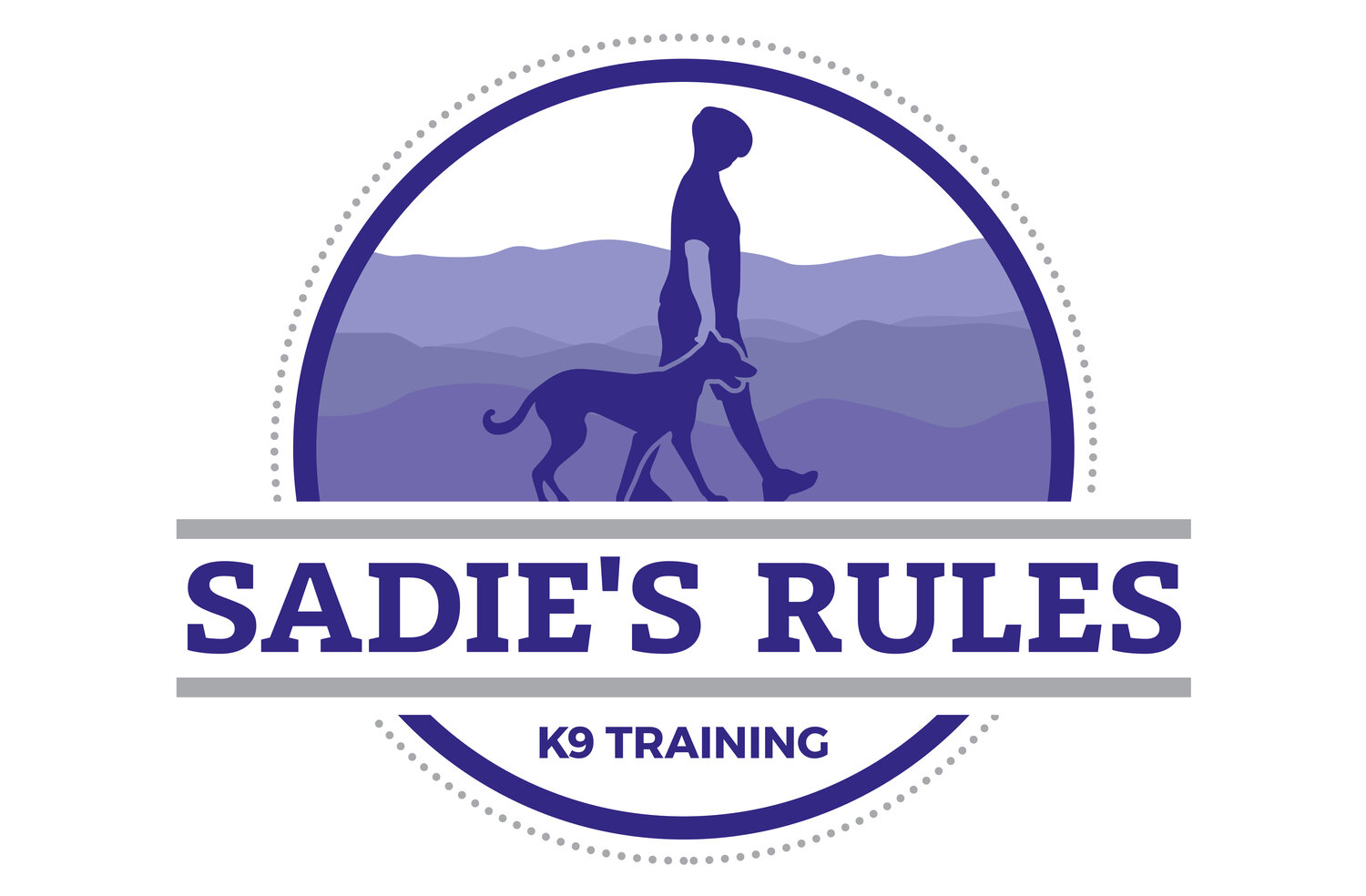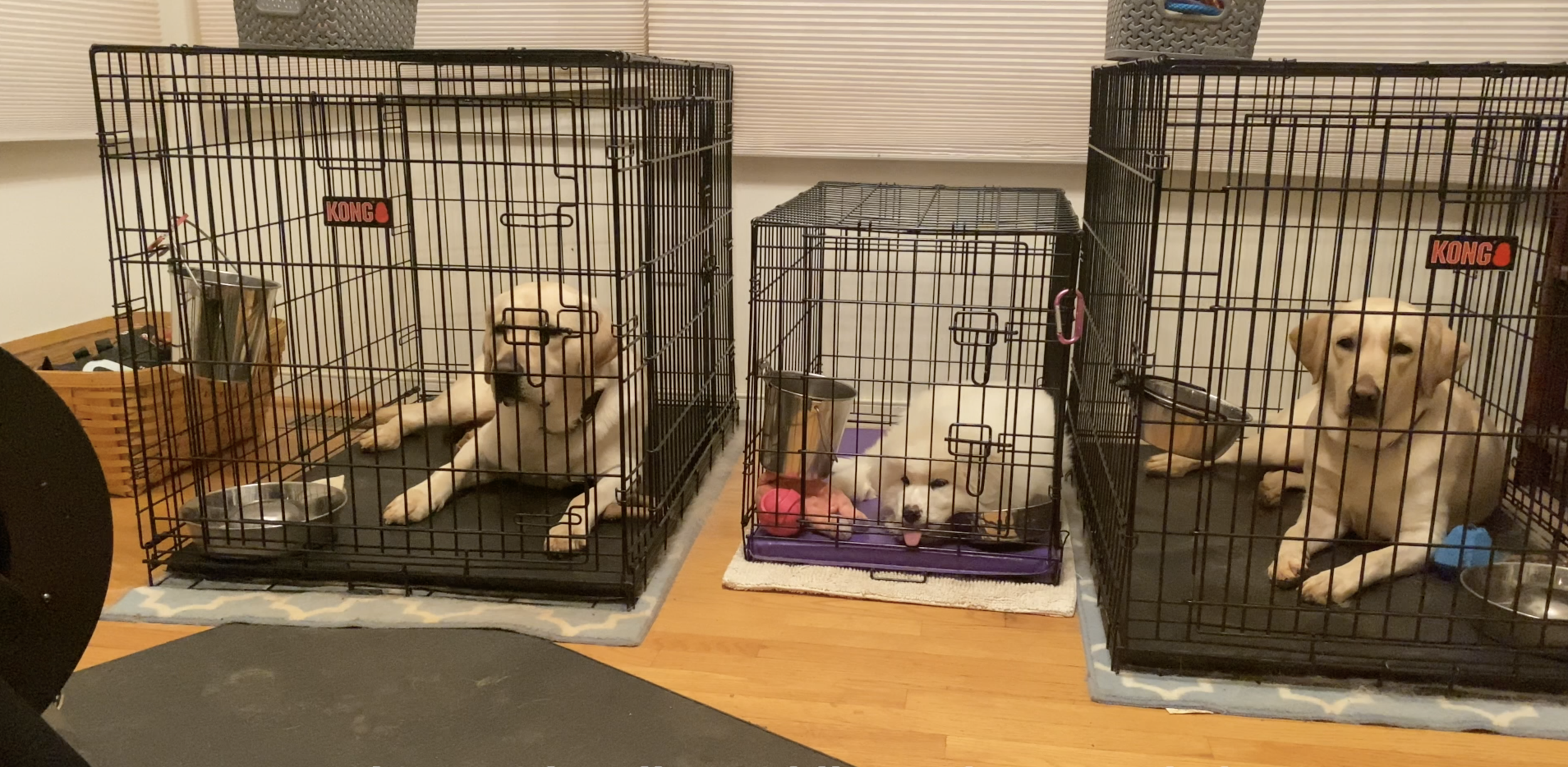The crate is a required part of training for all dogs, and it is required after training as well. For dogs who’ve never been crated or who haven’t been crated in a long time, this blog post will detail our advice on how to do a light crate reintroduction prior to the start of training. This post is intended for future clients, but anyone can utilize it to get their dog (re)acquainted with the crate.
Depending on your dog’s sensitivities you may not get through all of these steps and that’s okay; however, the further along you can get prior to training, the less time we’ll need to spend on your dog’s crate behavior during the board & train. This is also in your dog’s best interest, as they will be crated from day one of their board & train. If they’re already familiar with the crate, this will be a much easier transition.
Crate guidelines
Size - There is such a thing as a crate that’s too big, especially if your dog has issues in the crate. Err on the side of a crate that feels a little snug instead of a crate that gives your dog lots of room to pace, circle, and sprawl out. We want to encourage a dog to snuggle up and nap. You dog should have enough room to stand up, turn around and curl up comfortably.
Location - Do not put the crate in anyone’s bedroom—that is the most important rule. The crate should be located in a more central location within the home, not in anyone’s private space (like a bedroom) or in a space that feels isolated (like a spare room, an unfinished basement or a garage). A corner of the kitchen, family room, etc. is usually a good spot depending on your home’s layout and how you use your home.
Multiple crates - You can have an extra crate set aside for traveling so that your dog’s primary crate can stay in its place, but your dog should not have multiple crates within your home. ONE crate in a central location is important.
Respect privacy - Your crate is your dog’s personal space. Do NOT under any circumstances allow children, adults, other dogs, or other animals to enter your dog’s crate. We want your dog to know that this is their space to relax and let down their guard, and if that space is violated, then we’ve ruined the whole point of having a safe space.
Never crate dogs together in the same crate. If you’ve gotten away with this in the past, consider yourself lucky and discontinue this practice immediately. If tension develops, the dogs have nowhere to go and a fight will ensue. Even the best of friends have disagreements sometimes, but when they’re trapped in a small space together that can become deadly. Please do not risk it. Ever.
Items in the crate - If your dog is not inclined to chew their bedding, they can have a blanket or dog bed in the crate with them. If they sometimes eat/shred bedding, then it’s best to skip it. Ingested bedding can cause a blockage which is a medical emergency. For this reason, do not put rope toys or stuffed toys in your dog’s crate either. It is usually a good idea to put an appropriately sized hard chew, like a Benebone or a Nylabone. If your dog is still working on housebreaking, be careful about plush bedding—dogs like to urinate on blankets, beds, etc. Stick with a towel at the most.
instructions for a crate (re)introduction
Feed in the crate - A good place to start is by feeding your dog in their crate. This pairs something positive with the crate and gives your dog at least two times a day when they’ll eagerly get in. If your dog is really hesitant to enter the crate, start with the food bowl just inside the crate and then slowly place it further back as time goes on. You have time.
Closing the door - You can leave the door open at first and then start closing it as your dog gets more and more comfortable with the routine of eating in their crate. When you close the door, be careful not to make a big deal out of it—just close it and walk away like it's totally normal. If you stop and stare at your dog to see how they’re handling it, they’re much more likely to get upset. We call this the “fishbowl effect” and it’s very confusing for a dog. Resist the urge to stare.
Build in downtime - As your dog becomes comfortable with entering the crate to eat and having the door close behind them, start building in a period of downtime in the crate after they finish eating. They should rest their food before resuming activity anyway, so work up to a period of 20-30 minutes in the crate after finishing a meal. You can also start adding a period of downtime in the crate after exercise. Your dog will be ready for a nap anyway, so get into the routine of crating your dog for some down time immediately after physical and/or mental exercise (include both physical and mental whenever possible). So long as your dog is not inclined to chew their bedding, you can put one of their favorite beds or blankets in the crate to encourage your dog to relax and nap in the crate.
Experiment with crating at night and when home alone - Once your dog is comfortable in the crate and using it for periods of downtime, you can start to experiment with crating your dog when they’re home alone and for sleeping at night. Start with a short trip and slowly increase the time left alone.
mindset, tips & strategies
Don’t expect your dog to volunteer. You’re not looking for your dog to “willingly” get in the crate, per se. You’re trying to crate familiarity with the crate so that when you decide it’s time for your dog to get in the crate, they can do so with less resistance and a calmer mindset.
“Safe space” doesn’t mean what you think it means. Most folks will express concern that their dog doesn’t seem to “like” the crate. Their thought process is that if their dog truly sees the crate as a safe space, then their dog will want to get in. This is not the case. Creating a “safe space” in the crate means that the space is respected (i.e. it’s just for your dog and no one else violates that space), which means that the crate becomes a place where your dog can totally switch off and relax. This is different from napping in any other spot.
You will encounter some resistance. The goal is not to tip toe around your dog’s resistance to the crate; the goal is to help your dog through this resistance by utilizing a little strategy (pairing it with food) and to add the crate into your dog’s everyday life. If you only crate your dog when you leave, then your dog will always associate the crate with being alone, and that won’t help. The goal is to build the crate into your dog’s everyday life!
a few words about sleeping in the crate
When your dog first returns home from training they will need to sleep in their crate for at least the first 90 days, which is the immediate post-training period. Sleeping in the crate is a vital part of the post-training lifestyle, which is how we ensure that everything your dog learned at training—their skills and mindset—transfers home with them. You cannot skip this. We don't mean to be a stickler, but we don’t want to set you up for failure, and sleeping in the crate really is that big of a deal.
For a dog who resists the crate, momentum is especially important. Your dog will have learned to be calm in their crate while here at training, but in order for that skill to last, they will need the crate to remain a regular part of their lifestyle, including overnight. Crate skills are very much a "use it or lose it" kind of thing.
Sleeping outside the crate—and especially in your room and/or your bed—is a MASSIVE reward. Not all dogs can handle it. If you want to experiment with this after your dog’s first 90 days at home, you can. Here’s how you’ll know if your dog can handle it:
If your dog’s behavior in all other aspects of life does not deteriorate, then you can continue to allow your dog to sleep outside of their crate on some nights. Think of it as a reward for good behavior. If you give that reward every night, it becomes something your dog expects and/or demands, and it’s no longer a special reward.
If your dog’s behavior in ANY other area of life starts to backslide, then that confirms that your dog is not ready to handle the privilege of sleeping outside their crate. This freedom has “gone to their head” and is impacting their attitude and/or state of mind. Frankly, seeing this correlation makes it a bit easier on the human end of things. Right now, I know it's tough to see the connection between certain privileges and bad behavior, but it will be much clearer after training.
Last but not least, if your dog has other behavioral issues that are impacting their crate behavior and/or your ability to follow these instructions, please feel free to email us to ask about this. Above all, SAFETY FIRST! Always err on the side of caution.

